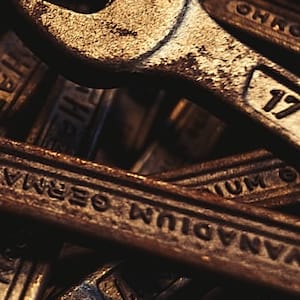throw a wrench in: Idiom Meaning and Origin
What does ‘throw a wrench in’ mean?
An idiom meaning to disrupt or interfere with a process, plan, or situation, usually causing it to go off track or fail.

Idiom Explorer
An idiom meaning in the way that something is done or in a particular style.
The idiom "with the manner" is an intriguing phrase that has captured the interest of many language enthusiasts. Derived from English, this idiom has a rich history and an assortment of meanings that have evolved over time. Exploring its origins and usages unveils fascinating insights into the intricacies of idiomatic language.
The idiom "up to something" means that someone is involved in a secret or mischievous activity, often with a sense of suspicion or curiosity surrounding their actions.
The idiom "upset the applecart" means to disrupt or spoil a carefully planned or established situation, often resulting in chaos or disorder.
The idiom "turn on one's heel" means to abruptly and decisively change direction, often in a gesture of annoyance or indignation.
The idiom *turn on its head* means to completely reverse or change something, especially an idea or situation, in a dramatic or unexpected way.
The idiom "turn-off" refers to something that causes a loss of interest or enthusiasm in a person or makes them feel repulsed or disgusted.
The idiom "turn of events" refers to an unexpected change or shift in a situation or sequence of events.
The idiom "turn of events" describes an unexpected or significant change in a situation or sequence of events. It denotes a shift in circumstances that alters the outcome or course of action in a surprising or unforeseen way. This widely recognized idiom is frequently used in both formal and informal contexts.
The idiom "turn on" means to switch on or activate something, or to suddenly become angry or hostile towards someone.
The idiom "turn on" is a commonly used phrase in the English language that has multiple meanings and usages. It is important to examine each context separately to understand the variations in its meaning.
The idiom "turn off" means to cause someone to feel disinterested or unattracted to something or someone.
Cracking the Hidden Meaning
The idiom "throw a wrench in" is a commonly used expression in American English. It is often used informally to describe the act of disrupting or obstructing a process, plan, or situation. The idiom originated in the early 20th century and has since gained popularity.
The phrase "throw a wrench in" is believed to have derived from its literal meaning. A wrench, also known as a spanner in British English, is a tool used for turning nuts and bolts. If a wrench is thrown into a machine or mechanism, it can cause it to malfunction or come to a complete stop. This mechanical disruption became a metaphorical representation of an action or event that hinders progress. The idiom is often used metaphorically to describe unexpected obstacles, complications, or disturbances that impede the smooth functioning of a system or plan.
The related idiom "throw a monkey wrench into the works" is another way to express the same idea. The phrase "monkey wrench" is another term for a wrench similar to a spanner. "Throwing a monkey wrench into the works" implies causing a disruption or obstacle that impedes progress, just like "throwing a wrench in." It is a colorful way to describe unexpected complications or disturbances that hinder the smooth progression of a process or plan.
The related idiom "throw a spanner in the works" is more commonly used in British English. The phrase "spanner in the works" is essentially synonymous with "monkey wrench in the works" and "throw a wrench in." It conveys the same meaning of unexpected obstacles or disruptions that hinder the smooth functioning or progression of something.
The idiom "throw a wrench in" can be used in various contexts, from personal situations to professional settings. For example, you might hear someone say, "The sudden illness of a key team member really threw a wrench in our project timeline." In this case, the idiom illustrates how an unforeseen circumstance disrupted the intended progress of a project.
Another example of the idiom's usage can be found in political contexts. A reporter might write, "The controversial decision by the President threw a wrench in the negotiations between the two countries." Here, the idiom highlights how an unexpected action affected the negotiations, potentially creating complications or obstacles that were not previously anticipated.
Furthermore, the idiom "throw a wrench in" is often used in conversations about personal relationships. For instance, someone might say, "Her sudden decision to move abroad really threw a wrench in our plans to get married." This usage demonstrates how an unexpected event or change disrupted the couple's plans and potentially caused conflict or difficulty in their relationship.
Overall, the idiom "throw a wrench in" has become a widely recognized and frequently used expression in American English. It serves as a useful shorthand for conveying the idea of unforeseen obstacles or disruptions that hinder the smooth progression of a process or plan. The vivid imagery of throwing a wrench into machinery helps to illustrate the immediate and often detrimental impacts such disruptions can have.
Whether discussing projects, politics, or personal relationships, this idiom captures the essence of the challenges that come with unexpected complications. It is a versatile expression that continues to be employed in everyday language, resonating with individuals who have experienced or witnessed the effects of a wrench being thrown in their own lives.
Example usage
1. The unexpected snowstorm threw a wrench in our plans to have a picnic at the park.
2. His sudden resignation from the project really threw a wrench in the team's progress.
3. Running out of gas on the highway really threw a wrench in our road trip.
More "Disruption" idioms

